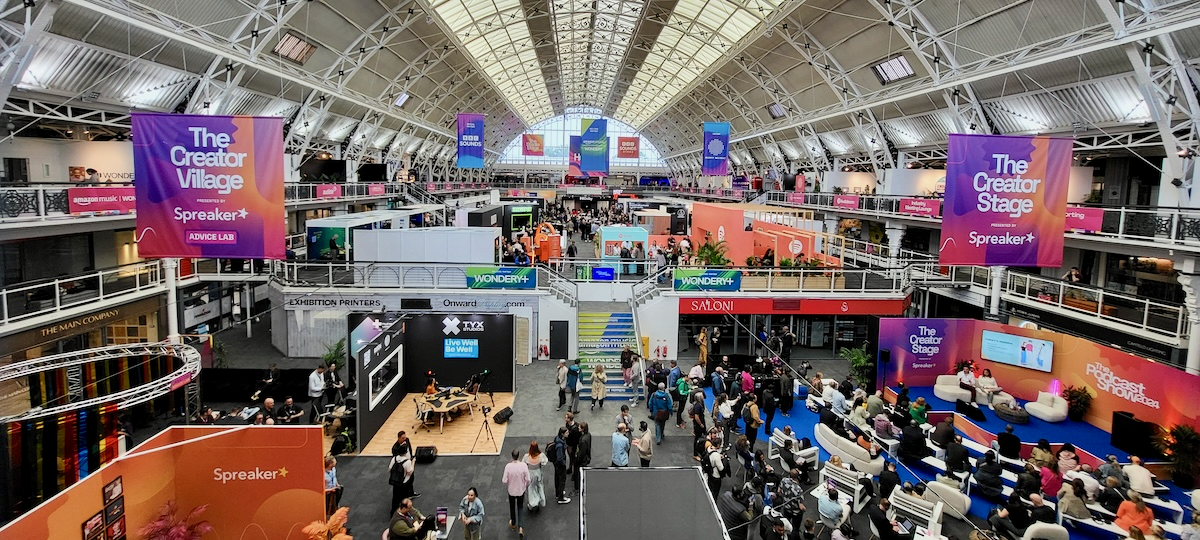
As a devoted son of radio, first lured to podcasting by the similarities, I’ve come to love spotting the differences.
The Podcast Show, last week, was a rare chance to do that on an industry-wide scale and I was among many from Bristol and the South West who flocked. This was the UK’s biggest coming together of what can sometimes feel like quite a fragmented fraternity, at least for the independent creator. The hours spent in my home studio writing, recording and editing are among the happiest of my freelance endeavours, but they are also quite isolating.
The people of podcasting have much in common with radio types, not least as so many straddle both worlds, yet the vibe en-masse is strangely different. The great Terry Wogan once described radio as “the home of the introverted egomaniac” and I relate to that entirely from my time in the industry. We’re the people you’ll always find in the kitchen at parties, quietly watching, tweeting and probably adding you on LinkedIn without making eye contact. Yet The Podcast Show was deafeningly loud at all times, people with much to say to each other. The atmosphere was strikingly friendly, welcoming and explosively sociable, perhaps in defiance of all the time we spend alone. For relative newbies like me at least, there was a sense of shared demystification, of everyone helping each other to make best sense of this wonderful craft that has landed from outer audio space…
Actually, as Bristol’s podcasters will know, so much is already understood. The podcast world is a canny fusion of marketing, PR and audio. Consequently, the industry is relentlessly driven by intelligent market research and targeted strategy, strikingly more so than the public service broadcast world I’ve inhabited for 20 years. This manifests itself as an absolute obsession with audiences, and rightly so: “Who we can serve, why and how…”, rather than “What we’d like to do…”. If you and I have ever worked together, or if we’ve had a coaching workshop together in recent months, you’ll understand why this makes me sing.
I lapped up the session ‘From Grey to Gold’ with Andy Goldsmith (from Adelicious) and Kat Farmer (from #gotthepodcast), which explained why canny podcasters should consider the over 55s. It has baffled me and angered many besides to see this growing audience abandoned by public service broadcasters, who really should be ramping up their commitment to an ageing population. We heard in the session that, not only is the older market growing in size, the over 55s hold 70% of the UK’s wealth; so it is perhaps even more perplexing that so few have seen the commercial potential of engaging them through audio. Known in the marketing world as “the blind spot”, this audience is targeted by only 3% of advertising briefs, typically health-related products, care homes and funeral plans. How crass! Among the marketing orgs represented by the speakers, 90% of briefs are targeted at 18-44 year olds, a decade adrift from those who will be spending 63p in every pound over the next ten years.
The reason cited for the vacuum (and I believe this to be true in radio, too) is that older people are not seen by the industry as a sexy audience to serve. Kat Farmer described an “echo chamber of young people in marketing talking to themselves…” and “…everyone imagining that anyone over 55 is like their nan”. We urgently need to get beyond that. I recently launched The Bus Inspectors podcast which is already thriving with older audiences. It takes a really niche subject to the mainstream – a grading scheme for the UK’s transport museums – and hopefully brings it to life with human interest stories that will light up those with curiosity. And, as I know from my work in BBC radio over the years, the over 55s are endlessly curious.
Having chosen to make The Bus Inspectors as a narrative podcast – that is, a crafted documentary rather than ‘chat show’ style – it was with some trepidation that I attended Miranda Sawyer’s session ‘Is Narrative Podcasting Dead?’. I have such respect for Miranda that, had the answer been ‘Yes, it’s dead’, I probably would think long and hard about my future. Fortunately, it was a complex but conclusive ‘No, it’s thriving… but it’s an art form… and narratives are more expensive to make… so you have to work much harder to pitch them’. This totally chimes. For many brands simply wanting ‘a podcast’, a freestyle chat is much quicker and cheaper to produce, so it’s no wonder narrative podcasts remain the exception. It’s also no wonder they really stand out and have a lasting value beyond most.
Other stand out messages came from Harry Morton, the Somerset-based CEO and founder of Lower Street Media, who talked about the importance of understanding, as a starting point, how your podcast fits into a wider landscape and ecosystem; and Fiona Fraser ‘The Podcast Expert’ whose simple message will actually be a profound revelation to many: “Your podcast is not for everyone”.
This is an industry which truly respects its audiences and is ever thoughtful about who will listen and how to reach them. No wonder it’s thriving.
Playful, imaginative communicator with 20 years' experience in daily live broadcasting, voiceover and audio production. Available for voiceover work from his own studio facility and as a presenter for radio, podcasts and live events.